|
Pharmacogn Rev. 2022;16(31):27-33 A multifaceted peer reviewed journal in the field of Pharmacognosy and Natural Products www.phcogrev.com | www.phcog.net |
Review Article |
Bug as a Drug. Lytta vesicatoria L. Applications in Nineteenth Century Official Medicine
Aleksander Karol Smakosz1,2
1Department of Pharmaceutical Biology and Biotechnology, Wroclaw Medical University, Wroclaw, Borowska, POLAND.
2The Doctoral School of Wroclaw Medical University, Wroclaw Medical University, Wroclaw, POLAND.
Correspondence
Aleksander K Smakosz, MPharm1,21
1Departament of Pharmaceutical Biology and Biotechnology, Wroclaw Medical University, Wroclaw, Borowska 211, POLAND.
2The Doctoral School of Wroclaw Medical University, Wroclaw Medical University, Wroclaw, POLAND.
E-mail: [email protected]
History
• Submission Date: 21-10-2021;
• Review completed: 17-11-2021;
• Accepted Date: 24-12-2021.
DOI : 10.5530/phrev.2022.16.5
Article Available online
http://www.phcogrev.com/v16/i31
Copyright
© 2022 Phcog.Net. This is an open-access article distributed under the terms of the Creative Commons Attribution 4.0 International license.

ABSTRACT
Nowadays the limited number of animal species are used in official medicine. For example, equine urine is a source of conjugated oestrogens used in menopausal hormone therapy; porcine intestine is the only approved source of anticoagulant and antithrombotic drug—enoxaparin. Until the end of nineteenth century animal-based medicines were very popular. Raw materials included substances obtained from mammals, birds, reptiles, and insects were used. Among insects the most important were red wood ant (Formica rufa L.), cochineal (Dactylopius coccus Costa), western honeybee (Apis mellifica L.) and cantharides (Lytta vesicatoria L.). Initially this species was only gathered in Spain. Because of that, this beetle was called Musca hispanica (spanish fly). In subsequent years it was found in other European countries such as France, Italy, Germany, Hungary, Poland, and Great Britain. In my research I have analyzed six European state pharmacopoeias published in nineteenth century—Pharmacopoea Regni Poloniae (1817), Pharmacopoea Fennica (1819), Pharmacopea Bavarica (1822), Pharmacopea Norvegica (1854), Pharmacopea Belgica (1854) and British Pharmacopoeia (1867). A total of 18 pharmaceutical preparations were noted. Among the analyzed sources, the most frequently reported pharmaceutical preparations were plaster of cantharides (Emplastrum Cantharidum) and ointment of cantharides (Unguentum Cantharidum)—these medications were found in all pharmacopoeias. Less common were tincture of cantharides (Tinctura Cantharidum), concentrated essence of cantharides (Essentia Cantharidum Fortior) and blistering paper (Charta epispatica) – they were presented in two works. Other drugs were reported individually. This study indicates the potential application of L. vesicatoria in contemporary medicine.
Key words: Cantharides, Ethnopharmacology, History of Pharmacy, Spanish Fly, Pharmacopoeia, Dosage forms.
Cite this article: Smakosz AK. Bug as a Drug. Lytta vesicatoria L. Applications in Nineteenth Century Official Medicine. Pharmacog Rev. 2022;16(31):27-33.
INTRODUCTION
The history of humankind is strongly connected with exploitation of natural resources. Fighting against starvation and illnesses were the basis of the formation of societies. The animal raw materials were gathered and used in various branches of industry, culture, and life science. Currently limited number of animal species are used in official medicine. For example, equine urine is a source of conjugated oestrogens used in treatment of menopausal hormone therapy; porcine intestine is the only approved source of anticoagulant and antithrombotic drug—enoxaparin.[1] But the application of animals as a source of medicinal resources in official medicine has gone. Usage of animal materia medica is still common in more traditional communities.[2,3]
Until the end of nineteenth century animal-based medicines were very popular. The used raw materials include substances obtained from mammals (human skull and fat, castoreum from beavers, musk from musk deer, “unicorn horn” from narwhal), birds (faeces of peafowl), reptiles (fat and skeleton of Avicenna viper) and insects.[4] Among insects the most important were red wood ant (Formica rufa L.), cochineal (Dactylopius coccus Costa.), European stag beetle (Lucanus cervus L.), western honeybee (Apis mellifica L.) and cantharides (Lytta vesicatoria L.).[4,5]
Lytta vesicatoria L.—source of Cantharidum
The source of described raw material is a beetle from the Meloidae family—Lytta vesicatoria L. This blister beetle is a slender, cylindrical insect with opalescent golden-green colour with blue gloss. It is approximately 1,5–3 cm long and 0,5–0,8 mm wide. The smell of this source is very strong with unpleasant mouse scent.[6] The appearance of described insect is shown in Figure 1.
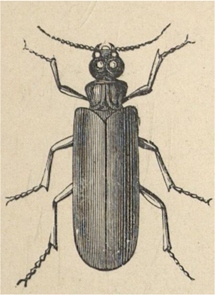
Figure 1: Lytta vesicatoria according to Atlas historji naturalnej [eng. Natural History Atlas] from 1900 Public domain.[10]
Initially this species was only found in Spain. For this reason, they called it Musca Hispanica (spanish fly). In subsequent years it was found in other European countries such as France, Italy, Germany, Hungary, Poland, Great Britain.[7,8] The imaginal stage of this insect feed on leaves on various trees. It is being found on plants from Oleaceae family such as: ash (Fraxinus spp.), privet (Ligustrum spp.), lilac (Syringa spp.); Caprifoliaceae: honeysuckle (Lonicera spp.); Adoxaceae: elder (Sambucus spp.).[7,9]
Gatherers of this raw material stretched the cloth around the tree, then shaken its branches. Fallen insects were collected into a container with water, alcohol, vinegar, or gasoline, or by exposure to the vapor of spirit, turpentine or vinegar.[6-8] After death (in imaginal state) they were quickly dried in the sun or with artificial heat.[6]
Powder of L. vesicatoria yields its active components (mainly cantharidin— tricyclic terpenoid) to alcohol, ether, fixed and volatile oils.[8] For this mentioned reason these ingredients were used as solvents during obtaining pharmaceutical preparations This drug was adulterated with Cetonia aurata L. and with euphorbium (resin obtained from various species of spurge e.g. Euphorbia resinifera A. Berger).[7-8]
In this article, I wanted to find out, in which drug forms L. vesicatoria was used, for which diseases it was applied, and how these remedies were prepared in 19th century European pharmacy.
MATERIALS AND METHODS
Literature search
The author conducted a literature search within the archive.org database using keywords such as “Pharmacopoeia” and “Pharmacopeia”, between 1819 and 1882 (published in Europe).[11] After reading the works, I selected the most relevant books for this article. Regarding the inclusion criteria, the works were selected depending on the inclusion based on the following topics: dosage forms of drugs based on cantharis, and their application. Exclusion criteria include the following: All other books that did not cover one of these topics as their primary endpoint. The binominal Latin names of plants were synchronized with The Plantlist database.[12]
The author searched works mentioned in section Sources for pharmaceutical preparations based on grounded L. vesicatoria. Then the author translated and comprised these recipes, their ingredients ratios, variability, names, and applications. It was assumed, that 1 uncia (ounce) is equivalent of 1/12 of libra and 1 drachma is equivalent of 1/8 of uncia. To simplify the calculations, it was assumed that 1 fluid ounce is equal to 1 uncia.
Sources
In the research author used six European state pharmacopoeias published in nineteenth century. The first one, Pharmacopoeia Regni Poloniae is considered to be the first Polish national pharmacopoeia. It was compiled by General Medical Council of the Kingdom of Poland and published in 1817 in Warsaw. This work is divided into three parts: Materia pharmaceutica, Preparata et composita and Ex tempore parranda.[13]
The second source was the Pharmacopoea Fennica. This work was published in 1819 under the privilege of the Prince of Finland. It is divided in two parts: Materia pharmaceutica and Preparata pharmaceutica. In the preface, it is placed Normae pharmaceuticae—pharmaceutical standards and rules of obtaining the materia medica, measuring and preparation of medications.[14]
Pharmacopoeia for the Kingdom of Bavaria or Pharmacopoea Bavarica, ordered by King of Bavaria was published in 1822. de Martius (probably Ernst Wilhelm Martius – German pharmacognosist and entomologist) took care of the description of medicinal raw materials (mineral, herbal and animal products). After the opening section, the medical council included Generalia—pharmacopoeial standard methods of measurement of density and energy (calories). The main text is divided in three volumes. First, Tomus primus is separated in three subsections—materia pharmaceutica animalis (animal sources), materia pharmaceutica mineralis (mineral sources), materia pharmaceutica vegetabilis (plant sources). Second volume, Tomus secundus is dedicated to synthetic and galenic pharmaceutical preparations. First subchapter—technica pharmaceutica lists the following formulations: acids, alcohols, tinctures, medicinal waters, medicinal powders, and other forms of the drug.[15]
Pharmacopoea Norvegica was published in 1854 under authority of king Oscar I of Sweden. It was first Norwegian national pharmacopoeia. This book is not divided in parts like the other ones pharmacopoeias. The main text is composed of descriptions of pure substances, raw materials and pharmaceutical preparations arranged in alphabetical order.[16]
New Belgian Pharmacopoeia or Pharmacopoea Belgica Nova is an 1854 successor of previous Pharmacopoea Belgica. This volume starts from pharmacopoeial standard methods of measurement. The main text is divided into sections dedicated to materia medica, pharmaceutical preparations, special drugs, and antidotes.[17]
The last pharmacopoeia used in research is British Pharmacopoeia from 1867. It was published under the direction of president of The General Council of Medical Education and Registration of the United Kingdom—dr. George Burrows. It was the first pharmacopoeia which replaced the previous local indices of medicines of British Isles. The main text is composed of descriptions of pure substances, raw materials and pharmaceutical preparations arranged in alphabetical order (like in Pharmacopoea Norvegica). The interesting part is tables, which describe the weight and measures standards, pharmaceutical symbols and books containing plates of officinal plants.[18]
RESULTS
Original Medicinal Uses
Carl Linnaeus in his well-known work about crude drugs—Materia medica per regna tria naturae [Medicinal sources from three kingdoms of nature] describes all species of animals and plants which was used in pharmacy and medicine in his contemporary times. In the chapter devoted to insects he described the cantharid under the name Meloë vesicatorius.[4] This description has been placed above with the author’s translation.
Original Latin text
VIS: inter. diuretica! aphrodisiaca, exter. corrosiva, exulcerans, excitans, revellans
USUS: intern. Ischuria, Hydrophobia, Hydrops, Gonorrhoea maligna. Exter. Febr- exanth maligna, Pleuritis, Morbi soporosi, Delirium, Ophthalmia, Paralysis, Asthma, Ulcera cacoëthica
Translation
Potency: internal [usage] diuretic! aphrodisiac, external [usage] irritating, fomentative, rousing, revulsive
Usage: internal [usage] ischuria, rabies, oedema, lues maligna. External [usage] maligna hyperthermia, pleurisy, coma, delirium, ophthalmitis, paralysis, asthma, necrotizing fasciitis
Pharmaceutical preparations based on L. vesicatoria Pharmacopoeia Regni Poloniae (1817)[13]
In materia medica part of Pharmacopoeia Regni Poloniae (Pharmacopoeia of Kingdom of Poland) the description of Cantharides has been placed alongside their appearance, foraging place, and method of obtaining. What is remarkable, the polish synonym of this source Muchy Hiszpańskie was also provided. The first analyzed formula is Emplastrum Cantharidum Ordinarium (basic plaster of cantharides; page 106). It contains 1 libra of beeswax, 3 unciae of turpentine and purified pork lard and half uncia of ground cantharides (Figure 2). The first three ingredients were melted, then the powder of L. vesicatoria was added, mixed and the plaster were formulated. The ratio of used ingredients is 24:6:6:1 (beeswax:turpentine:lard:cantharides).[13]
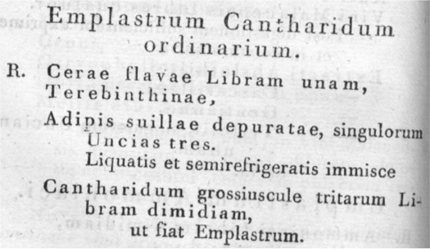
Figure 2: Recipe for basic plaster of cantharides according to Pharmacopoeia Regni Poloniae (1817), Public domain.[13]
Second plaster mentioned in this volume is Emplastrum Cantharidum Perpetuum (constant plaster of cantharides; page 107). It was composed of 2 unciae of grounded cantharides, 1 uncia of euphorbium (resin obtained from E. resinifera) and one libra of turpentine and pine resin (obtained from Pinus sylvestris L.). The process of formulation was analogical to theprevious one (melting and mixing the resins, then adding the cantharides. The ratio of used ingredients is 1:12:12:2 (euphorbium:turpentine:pine resin:cantharides).
Tinctura Cantharidum (tincture of cantharides; page 167) according to this pharmacopoeia consist of half uncia of cantharides and 1 libra of spirit. Raw material was macerated in alcohol in cold place for 3 days and filtered. The ratio of used ingredients is 24:1 (alcohol:cantharides).
Unguentum Cantharidum (ointment of cantharides; page 175) was compounded by mixing 2 unciae of crashed cantharides with 8 unciae of poppyseed oil (obtained from Papaver somniferum L.) and heating in water bath. After 2 hr the mixture was strained and half libra of this compound was added to 4 unciae of beeswax. The ratio of used ingredients in final product is 4:4,8:1,2 (beeswax:oil:cantharides).
Pharmacopoea Fennica (1819)[14]
In another European state pharmacopoeia—Pharmacopoea Fennica (Finnish Pharmacopoeia) first recipe based on blister bettle is Emplastrum Cantharidum (plaster of cantharides; page 48). It consisted of 10 unciae of beeswax, 3 unciae of turpentine and olive oil (obtained from Olea europaea L.) and 6 unciae of cantharides. Oil, wax, and turpentine was melted, then the grindeded cantharides were added. This mixture was heated on the fire for hour, then strained and cooled. The ratio of used ingredients is 10:3:3:6 (beeswax:turpentine:oil:cantharides).[14]
Tinctura cantharidum (tincture of cantharides; page 85) was prepared by maceration of 0,5 uncia of cantharides in 1 libra of spirit in cold place for 8 days. Then the tincture was strained thought the filtration paper. The ratio of used ingredients is 24:1 (alcohol:cantharides).
Unguentum Cantharidum (ointment of cantharides; page 91) was compounded by mixing 1 libra of cantharides with 4 librae of Unguenti terebinthinae resinosi (3 unciae of rosin, lanolin, turpentine, and beeswax heated and mixed with libra of olive oil). The ratio of used ingredients in final product is 1:1:4:1:1:2 (beeswax:turpentine:oil:lanolin:rosin:can tharides).
Second ointment mentioned in this work is Unguentum Cantharidum Colatum (filtered plaster of cantharides; page 92). It was prepared by mixing 1 libra of above medicine – ointment of cantharides, filtered through linen cloth with 2 drachmae of copper(II) sulfate with 1 libra of olive oil (Figure 3). The ratio of used ingredients is 12:12:0,25 (cantharides ointment:olive:copper(II) sulfate).
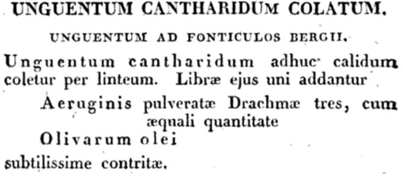
Figure 3: Recipe for filtered cantharis plaster according to Pharmacopoea Fennica (1819), Public domain.[14]
Pharmacopoea Bavarica (1822)[15]
In one of German state Pharmacopoeia—Bavarian Pharmacopoeia (Pharmacopoea Bavarica) there is no description of L. vesicatoria as a crude drug. Nevertheless, there is several recipes based on described insect. The first of these is Alcohol Cantharidum (tincture of cantharides; page 161). This drug was formulated by simple maceration one part of cantharides in 6 parts of spirit for 3 days. This brown tincture turned green when water was added (Figure 4).

Figure 4: Recipe for tincture of cantharides according to Pharmacopoea Bavarica (1822), Public domain.[15]
Emplastrum Cantharidum Cereum (plaster of cantharides with wax; page 185) was manufactured by melting 4 parts of beeswax with 1 part of olive oil. Then 1 part of turpentine and 2 parts of ground cantharides were added to this mixture. This formula ends with a warning of the dangerous effects of this medicine (toxicity).
The last formula incorporated in this pharmacopoeia is Unguentum Cantharidum Cereum (ointment of cantharides with wax; page 268). It was prepared by digestion 1 part of cantharides with 2 parts of spirit for 24 hr. Then 4 parts of almond oil (Prunus dulcis (Mill.) D.A.Webb) were added, mixed and heated until all the alcohol has been vaporized. In last step this blend was heated with 1,5 parts of beeswax.
Pharmacopoea Norvegica (1854)[16]
In Pharmacopoea Norvegica (Norvegian Pharmacopoeia) first mentioned prescription was for Emplastrum Catharidum Colatum (filtered plaster of cantharides; page 40). This medicine was prepared by mixing (in porcelain or copper container) 8 parts of pulverized L. vesicatoria and rosin, 5 parts of beeswax and 2 parts of tallow (obtained from Bos taurus L.). Then the vessel was heated in water bath till the fusion of all compounds. In next step 1 part of Picea abies (L.) H. Karst or P. sylvestris turpentine was added. In the last step the mixture was cooled and put on special sheet.
Emplastrum Cantharidum Ordinarium (ordinary plaster of cantharides; page 40) was formulated by mixing and heating 10 parts of beeswax, 3 parts of turpentine and oil, and 6 parts of powder of cantharides.
Emplastrum Cantharidum Perpetuum (constant plaster of cantharides; page 41) was prepared by incorporation the following components: 12 parts of melted turpentine and mastic (obtained from Pistacia lentiscus L.), 3 parts of ground cantharides and 2 parts of pulverized euphorbium. In the last step the mixture was cooled and put on special sheet (Figure 6).
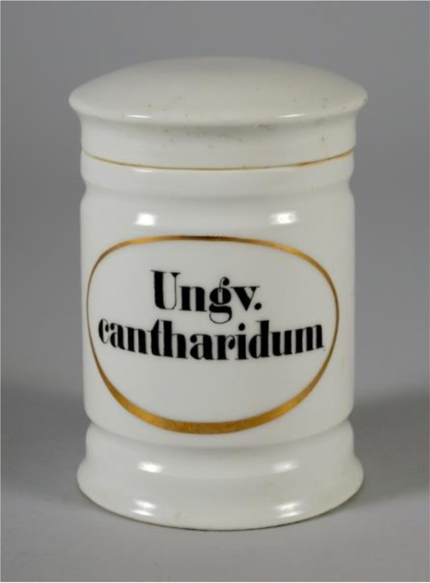
Figure 5: Apothecary ointment of cantharides jar. From collection of Sverresborg Trøndelag Folkemuseum (Norway). CC BY-NC-SA 4.0 license.

Figure 6: Recipe for constant plaster of cantharides according to Pharacopoea Norvegica (1854), Public domain.[16]
This pharmacopoeia contains two recipes for tinctures: Essentia Cantharidum (essence of cantharides; page 50) and Essentia Cantharidum Fortior (concentrated essence of cantharides; page 50). The only difference between these two formulations were ingredients ratio: 1:30 in first and 1:5 in second formula. These essences were produced by digestion the pulverized L. vescatoria under reflux condenser.
Oleum Cantharidum Infusum (infused oil of cantharides; page 103) was prepared by heating the vessel with 1 part of pulverized Spanish fly with 4 parts of oil in steam bath for 6 hr and filtration of medicine.
Recipe for Unguentum Cantharidum (ointment of cantharides; page 174). was almost the same as Emplastrum Cantharidum Colatum. The only difference was ratio—1 part of colophony, tallow and beeswax was mixed with 2 parts of ground cantharides, 4 parts of oil and heated in 90–100 Celsius degrees. In the next step 1 part of turpentine was added (Figure 5).
Pharmacopoea Belgica nova (1854)[17]
The New Belgian Pharmacopoeia (Pharmacopoea Belgica nova) contains the highest number of recipes among the analyzed pharmacopoeias (de Hemptinne 1854). The method of preparation of plasters is comparable to those mentioned earlier. Emplastrum Cantharidum (plaster of cantharides; page 161) was prepared by mixing 480 parts of beeswax, 420 parts of Venetian turpentine (obtained from Larix decidua Mill.), and olive oil with 280 parts of pulverized L. vesicatoria. Emplastrum Cantharidum Anglicum (English plaster of cantharides; page 161) was formulated by mixing 203 parts of beeswax and lanolin, 94 parts of rosin, 169 parts of pork lard with 332 parts of pulverized cantharides. Emplastrum Cantharidum Camphoratum (camphor plaster of cantharides; page 162) was compounded by mixing 96 parts of above plaster of cantharides with 4 parts camphor with small amount of olive oil. The last plaster—Emplastrum Cantharidum Perpetuum (constant plaster of cantharides; page 162) was prepared by mixing 387 parts of mastic, 387 parts of Venetian turpentine, 33 parts of pork lard with 64 parts of pulverized euphorbium and 429 parts of cantharides.
Oleum cantharidatum (oil of cantharides; page 202) was prepared in a unique way 100 parts of pulverized cantharides were boiled with 500 parts of water for 6 hr. In the next step this decoction was strained and reduced into 300 parts in bain-marie. In last step 1000 parts of olive oil was poured and gently heated for 15 min; then the mixture was cooled, and the oil phase was separated from water.
Tinctura Cantharidum Aetherea (ethereal tincture of cantharides; page 264) was done by simple percolation of 200 parts of ground L. vesicatoria with 400 parts of ether. After 20 hr tincture was collected and once again 400 parts of solvent were added. After 6 hr of second percolation following part of tincture was collected. The remaining raw material was pressed out; squeezed fluid was added to previous part of tincture and the ether was poured up to 1000 parts of tincture.
In the described pharmacopoeia were found four recipes for ointment. First, Unguentum Cantharidum Album / Unguentum Perpetuum (white ointment of cantharides /constant ointment of cantharides; page 274) was prepared by boiling 100 parts of ground cantharides with 1000 parts of water for 6 hr. Then decoction was strained and reduced to 6 parts. In next step 857 parts of pork lard and 143 parts of beeswax were added and this mixture was heated for 15 min. In last step this medicine was cooled, and water part was removed.
Unguentum Cantharidum Nigrum (black ointment of cantharides; page 274) and Unguentum Cantharidum Viride (green ointment of cantharides; page 275) were compounded medicines. In first case it was mixture of 150 parts of cantharides and 850 parts of simple ointment (850 parts of port lard, 150 parts of beeswax). In second case it was mixture of 30 parts of cantharides, 319 parts of olive oil, 175 parts of beeswax and 476 parts of poplar ointment (200 parts of Populus spp. buds, 125 parts of Hyoscyamus niger L. and Atropa belladonna L. leaves, 500 parts of water and 1000 parts of pork lard).
Charta epispatica (blistering paper; page 319) was prepared by immersion of paper in melted mixture of 78–90 parts of crushed L. vesicatoria, 433 parts of beeswax, 217 parts of spermaceti (obtained from Physeter macrocephalus L.), 217 parts of oleoresin Elemi (obtained from Canarium luzonicum (Blume) A.Gray), and 153 parts of Venetian turpentine.
Collodium cantharidatum (collodion of cantharides; page 320) was formulated in two phases. In first one 500 parts of ground cantharides were percolated in mixture of 500 parts of ether and 90 parts of ethyl acetate. In second phase 100 parts of this extract were mixed with 2 parts of cellulose nitrate (Figure 8).
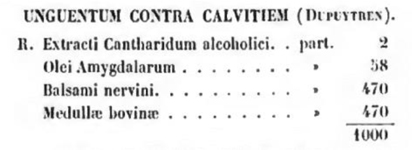
Figure 7: Recipe for Unguentum Contra Calvitem (ointment against baldness; page 341). Public domain.[17]
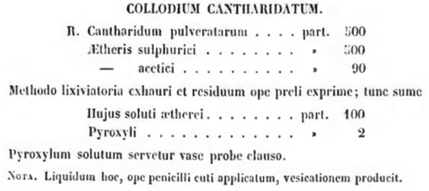
Figure 8: Recipe for collodion of cantharides according to Pharmacopea Belgica Nova. Public domain.[17]
British Pharmacopoeia (1867)[18]
Acetum cantharidis (vinegar of cantharides; page 2) was prepared by mixing 13 fluid ounces of acetic acid with 2 ounces of anhydrous acetic acid. Then in this blend 2 ounces of cantharides in powder was poured and digested for 2 hr in 93 Celsius degree. In next step this mixture was put into percolator, and when the liquid ceased to pass, 5 fluid ounces of acetic acid over the residuum in the apparatus were poured. As soon as the percolation were complete, the liquids were mixed with enough acetic acid to get 20 fluid ounces. The ratio of used ingredients is 20:2 (vinegar:cantharides).
Emplastrum cantharidis (cantharis plaster; page 105) was prepared by liquidation of 7,5 unciae of beeswax and suet (obtained from B. taurus) and 6 unciae of lard on water bath. Then 3 unciae of resin and 12 unciae of cantharides were added. The ratio of used ingredients is 7,5:7,5:6:3:12 (beeswax:suet:lard:resin:cantharides).
Tinctura Cantharidis (tincture of cantharides; page 323) was prepared by simple maceration of 0,25 uncia of ground L. vesicatoria in 20 liquid ounces of spirit for 7 days. The ratio of used ingredients is 80:1 (spirit:cantharides).
Unguentum Cantharidis (ointment of cantharides; page 353) was compounded by infusion of 1 uncia of cantharides in 6 fluid ounces of olive oil for 12 hr. Then this medicinal oil was put in baine-marine for 15 min and strained. In last step 1 uncia of beeswax was added. The ratio of used ingredients is 6:1:1 (oil:wax:cantharides)
Unguentum contra calvitem (ointment against baldness) was prepared by mixing the nervine ointment (470 parts) with almond oil (Prunus dulcis (Mill.) D.A.Webb) (58 parts), extract of cantharides (2 parts) and bovine bone marrow (470 parts) (Figure 7).
DISCUSSION AND CONCLUSION
The raw material described above was used externally mainly as blistering agent and local irritant; also, in chronic gonorrhoea, paralysis, lepra, ulcers therapy. Spanish fly was used internally as a diuretic stimulant and aphrodisiac. In large doses it is a very dangerous poison causing severe inflammation and irritation of internal organs. In acute poisoning suppression of urine, excessive priapism, headache, delirium, convulsions, coma, and death were observed. Lethal dose is 1,6 g of L. vesicatoria, what is equivalent of 10–50 mg of pure cantharidin.[8]
The pharmacists and doctors in nineteenth century believed, that the best pharmaceutic form (used internally) based on cantharides is tincture. The plasters (Emplastra) based on Cantharidum were held on skin for 2–3 hr.[6] If Carried longer (4–5 h) large blisters were produced. After 24 hr yellow liquid is produced, and hard healing wounds are formed. They could heal even for six months.[7]
According to some authors the aphrodisiac effect occurs only in subtoxic dose.[6] Moreover, they believed that this action is possible when cantharidin is absorbed into the bloodstream.[6] It is worth to notice, that this substance may irritate the urethra when excreted in urine, resulting in the congestion of the reproductive organs.[6,8]
The pharmacists and doctors in nineteenth century believed, that the best pharmaceutic form (used internally) based on cantharides is tincture. The plasters (Emplastra) based on Cantharidum were held on skin for 2–3 hr.[6] If Carried longer (4–5 hr) large blisters were produced. After 24 hr yellow liquid is produced, and hard healing wounds are formed. They could heal even for six months.[7]
According to some authors the aphrodisiac effect occurs only in subtoxic dose.[6] Moreover, they believed that this action is possible when cantharidin is absorbed into the bloodstream.[6] It is worth to notice, that this substance may irritate the urethra when excreted in urine, resulting in the congestion of the reproductive organs.[6,8]
Among the analyzed sources, the most frequently reported pharmaceutical preparations are plaster of cantharides (Emplastrum Cantharidum) and ointment of cantharides (Unguentum Cantharidum)—these medications were found in all pharmacopoeias. Less common were tincture of cantharides (Tinctura Cantharidum), concentrated essence of cantharides (Essentia Cantharidum Fortior) and blistering paper (Charta epispatica)—they were present in two works. Other drugs were reported individually.
The described formulae for the tincture of cantharides differ from the recipe mentioned in P. Hernquist manuscript Zoopharmacologia from the first part of nineteenth century.[19] According to L. E. Appelgren (2010) this preparation was formulated by maceration of 3 unciae of cantharides with 0,5 uncia of camphor and 1,5 drachms of nitric acid in 1 measure [sic] of spirit. After the appropriate number of days, it was filtrated. In described formulae alcoholic tincture was prepared by simple maceration and filtration of crude drug. P. Hernquist also supposedly describe irritating, proinflammatory and diuretic properties of Lytta vesicatoria and its products.[19] This description of pharmacological properties is identical to these mentioned by Carl Linnaeus (1772) and editors of state pharmacopoeias.
The biggest noted concentrations of cantharides were 34%—Emplastrum Catharidum Colatum (Norwegian Pharmacopoeia). Slightly lower (33%) in the case of Emplastrum Cantharidum Perpetuum (New Belgian Pharmacopoeia) and Emplastrum Cantharidis (British Pharmacopoeia). The comparison of drugs mentioned in described sources is shown in Table 1.
Table 1: The comparison of drugs described in various pharmacopoeias.[13–18]
| Pharmaceutical preparation | Ph. Reg. Pol. 1817 | Ph. Fenn. 1819 | Ph. Bav. 1822 | Ph. Norv. 1854 | Ph. Belg. 1854 | Ph. Br. 1867 |
|---|---|---|---|---|---|---|
| Acetum cantharidis | - | - | - | - | - | + |
| Charta epispatica | - | - | - | - | + | + |
| Collodion cantharidatum | - | - | - | - | + | - |
| Emplastrum calefaciens | - | - | - | - | - | + |
| Emplastrum Cantharidum Camphoratum | - | - | - | - | + | - |
| Emplastrum Catharidum Colatum | - | - | - | + | - | - |
| Emplastrum Cantharidum (Ordinarium/Cereum) | + | + | + | + | + | + |
| Emplastrum Cantharidum Perpetuum | + | - | - | + | + | - |
| Essentia/Tinctura/Alcohol Cantharidum | + | + | + | + | - | + |
| Essentia Cantharidum Fortior | - | - | + | + | - | - |
| Oleum Cantharidum Infusum | - | - | - | + | + | - |
| Tinctura Cantharidum Aetherea | - | - | - | - | + | - |
| Unguentum Cantharidum (Cereum) | + | + | + | + | - | + |
| Unguentum Cantharidum Album | - | - | - | - | + | - |
| Unguentum Cantharidum Colatum | - | + | - | - | - | - |
| Unguentum Cantharidum Nigrum | - | - | - | - | + | - |
| Unguentum Cantharidum Viride | - | - | - | - | + | - |
| Unguentum Contra Calvitem | - | - | - | - | + | - |
Legend: Ph. Reg. Pol.—Pharmacopoeia Regni Poloniae, Ph. Fenn. —Pharmacopoea Fennica, Ph. Bav—Pharmacopoea Bavarica, Ph. Norv—Pharmacopoea Norvegica, Ph. Br.—British Pharmacopoeia.
Currently the cantharidin in US, in the form of collodion, is used in the treatment of warts and molluscum. The most common concentration of this terpenoid, used in these medications, is 0,7%.[20] It was also proven that this substance act as a vasoconstrictor in human cardiac tissue (Puerto Galvis et al. 2013). Other compounds, based on cantharidin (norcantharidin, cantharidimide, norcantharimide), because of their inhibitory activity of phosphoprotein phosphatases could be efficient in treatment of cancer.[21] This study indicates the potential applications of L. vesicatoria in contemporary medicine. Also, it may inspire further clinical trials and research.
ACKNOWLEDGEMENT
The author wishes to thank Piotr Czerwik for the review of the manuscript.
CONFLICT OF INTEREST
The authors declare that there is no conflict of interest.
REFERENCES
1. Queensland Health. Medicines/pharmaceuticals of animal origin. 2020 [cited Sep 10 2021]. Available from: https://www.health.qld.gov.au/__data/assets/pdf_file/0024/147507/qh-gdl-954.pdf.
2. Alves RRN, Rosa IL. Zootherapy goes to town: The use of animal-based remedies in urban areas of NE and N Brazil. J Ethnopharmacol. 2007;113(3):541-55. doi: 10.1016/j.jep.2007.07.015, PMID 17719192.
3. Martínez GJ. Use of fauna in the traditional medicine of native Toba (qom) from the Argentine Gran Chaco region: an ethnozoological and conservationist approach. Ethnobio Conserv. 2013 May 2:1-43. doi: 10.15451/ec2013-8-2.2-1-43.
4. Von Linné C. Materia medica per regna tria naturae: secundum genera differentias synomyma loca durationes culturas nomina Simplicia praeparata qualitates modos potentias vires usus Composita. Editio Altera. Leipzig and Erlangen: Wolfgang Waltherum; 1772. p. 1-26.
5. Dasal M, Smakosz A, Kurzyna W, Rudko M. “Unicorn horn” drugs in the medical and pharmaceutical culture of Europe. Farm Pol. 2021;77(2):84-94. doi: 10.32383/farmpol/135093.
6. Farmakognozja MJ. [Pharmacognosy]. [Vilnus Tow Wydawnicze pogon]. 1933:549-51.
7. Alexander W. Tentamen medicum de cantharidum historia ac usu. Edinburgh. Balfour: Auld et Smellie; 1769;1-32.
8. Christison R. A dispensatory or commentary on the pharmacopoeias of Great Britain. Edinburgh: Adam and Charles Black; 1848;260-7.
9. Polish Biodiversity Information Network. [Database on the internet. Lytta (lytta) Vesicatoria Vesicatoria Linnaeus]. 1758;2020.
10. Arendts C. Atlas historji naturalnej [natural history atlas]. M. Arct. Warszawa; 1900. p. 45.
11. Archive.org. [Database on the internet]. Archive.org.
12. The Plant List [database on the internet]. Version 1.1; 2013 [cited Oct 20 2021]. Available from: http://www.theplantlist.org.
13. Consilio supremo sanitatis. Pharmacopoeia Reg Pol Varsoviae Typographia Juxta Novolipium Nro. Vol. 646; 1817.
14. Pharmacopoea fennica. Turku: Fredrici ant. Meyer. 1819.
15. Pharmacopoea bavarica. Munich: Josephi Lindauer; 1822.
16. Pharmacopoea norvegica. Copenhagen: Brögger and Christie; 1854.
17. De Hemptinne AD. Pharmacopoea belgica nova. [Bruxell J B Tircher Vandooren]. 1854.
18. British Pharmacopoeia. London: Spottiswoode and Co.; 1867.
19. Appelgren LE. Spanish flies in the Veterinary Pharmacy in Skara – their medicinal use yesterday and today. Hist Med Vet. 2010;35(2):35-48. PMID 21932470.
20. Moed L, Shwayder TA, Chang MW. Cantharidin revisited: A blistering defense of an ancient medicine. Arch Dermatol. 2001;137(10):1357-60. doi: 10.1001/archderm.137.10.1357, PMID 11594862.
21. Puerto Galvis CE, Vargas Méndez LY, Kouznetsov VV. Cantharidin-based small molecules as potential therapeutic agents. Chem Biol Drug Des. 2013;82(5):477-99. doi: 10.1111/cbdd.12180, PMID 23809227.
Cite this article: Smakosz AK. Bug as a Drug. Lytta vesicatoria L. Applications in Nineteenth Century Official Medicine. Pharmacog Rev. 2022;16(31):27-33.